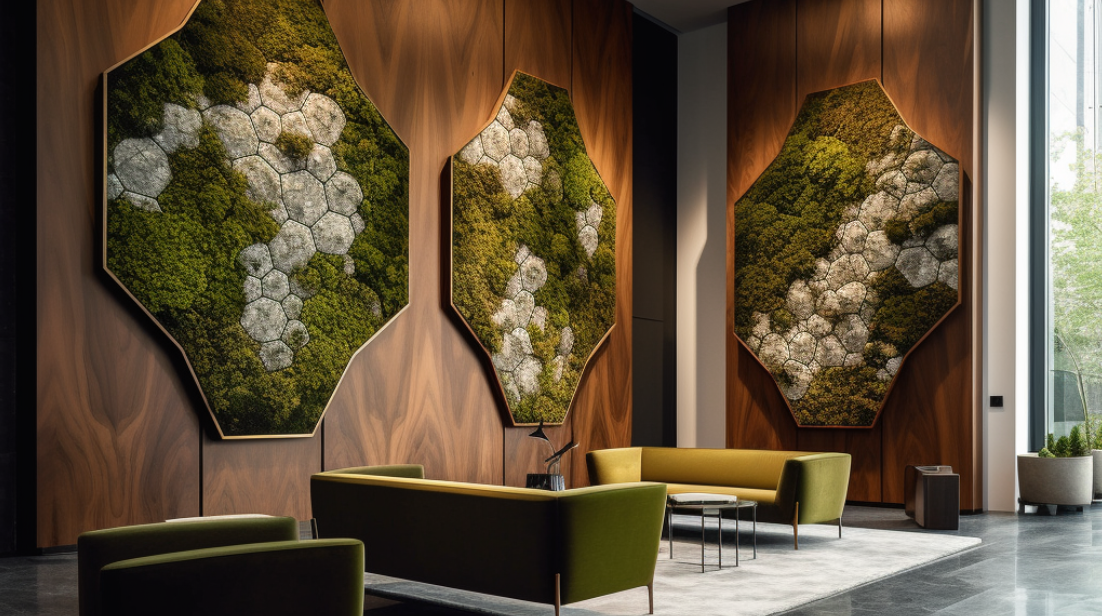Moss art in education: a tool for reflection and problem-solving
Burak Can, department chair at Data Analytics and Digitalisation (SBE) and a social entrepreneur, hosted an unconventional workshop during the 2023 UM Education Days in Maastricht. In this session, teachers, educators, and students created an art piece using moss, engaging in a unique approach to self-reflection and problem-solving.
It all started with a dry throat
Burak’s journey into moss art began with a personal worry – his son’s recurrent dry throat caused by poor indoor air quality. Experimenting with open-source sensors and microprocessors to assess air quality, Burak investigated the use of plants to regulate indoor humidity. “I spent a significant amount of time testing different types of plants and measuring their effectiveness in absorbing CO2. And all of sudden, I thought: ‘Why not use moss instead?’”
Burak conducted research on live moss with students from the Maastricht Sustainability Institute: “Moss is a very effective carbon absorber because it is multi-dimensional, fully green, and it covers surfaces more efficiently than other plants. It can be used to create beautiful wall decorations thanks to its numerous leaves, soft texture and interesting branch structures. And it’s very resilient, too. My prototypes have managed to survive me!”

"I didn't want to bore myself"
During UM Education Days 2023, Burak hosted a workshop exploring moss and organic materials as tools for visualising educational challenges. His motivation was very simple: “I didn’t want to bore myself and others with a lecture,” he laughed.
With the catchy title "Moss-map your education", the activity invited participants to reflect on obstacles encountered in teaching and learning, using moss as a medium for expression. "Educators face a variety of challenges every day," he said, "'due to the complexity of reaching consensus within diverse teams. Everybody has a different perspective, so it can be tricky to find agreement.”
Offload your brain
Burak encouraged participants to think about challenges they had encountered in their teaching and learning activities and to write them down. These challenges could be anything, from designing or revising a course to everyday situations in the classroom or with colleagues. “When you’re stuck in a problem in your mind, putting it on a piece of paper already offloads your brain,” he observed.
Then, Burak asked everyone to identify a challenge they wished to portray through art. The participants started brainstorming and sketched their ideas on paper, considering the people involved and the obstacles and opportunities related to their challenges. Next, they selected a piece of wood as the base for their artwork. Then, they set off to gather materials like stones, pine cones, leaves, flowers, clay, and moss to bring their sketches to life as tangible decorative pieces.
“It was really fascinating to see people’s creativity come alive during the workshop. I encouraged them to explore and go beyond the materials I provided. One colleague from SBE found a beautiful wood chunk in the garden and decided to use it for her artwork. She added various leaves, sticks, branches, twigs, and stones and created a truly captivating piece.”
Turning educational challenges into creative actions
Most challenges were related to issues like lack of collaboration, pushback, or dealing with complex projects with too many people and meetings. Turning these challenges into art seemed to help participants to relax and forget their problems for a while.
Burak was surprised to discover the educational value of this exercise: “My original purpose with the workshop was to have fun while doing some artistic expression, but I found that the educational value of this exercise was that people actually learned a way to see their challenges as opportunities for creation. I realised that blending a fun activity with problem-solving could spark artistic expression and lead to a creative experience. This was a valuable lesson for me.”
Photo impression: Enthusiastic participants "moss-mapping" their education
Finding beauty in adversity
Burak highlighted the workshop’s unconventional yet effective approach: “As they crafted their moss maps, participants took ownership not only of their creations but also of the challenges they represented. They transformed their problems into opportunities for artistic exploration.”
Looking ahead: moss art with a twist!
For Burak, moss serves as a powerful metaphor for resilience and adaptability: "Moss possesses remarkable qualities, including its ability to regulate humidity and withstand diverse conditions." He envisions further exploring the plant's resilience and adaptability, connecting these qualities to personal growth and emotional regulation.
Participants can anticipate another engaging workshop, blending art, creativity and reflection, during the next UM Education Days!
By Lia Krizova, EDLAB Student Assistant, Bachelor Student FASoS
This article is a publication of edUMinded, the Maastricht University online magazine on Teaching & Learning.
Interested in more Teaching & Learning insights?
Also read
-
UM builds open education and digital literacy into BKO/UTQ
Maastricht University is taking a practical step to support early-career teachers: open education and digital literacy will be built more firmly into the BKO/UTQ.
-
Celebrating 221 UM teachers who earned their University Teaching Qualification!
Educators from FHML (114), SBE (22), FSE (15), Law (33), FASoS (23), and FPN (14) have officially joined the ranks of UTQ-certified teachers.
-
If a machine can write a flawless essay, what’s left for the writer?
UCM graduate Robin van Wasen traces how writing has shaped her learning, identity, and voice, and asks whether AI, despite its fluency, can ever replace the intent, authenticity, and connection that define human writing.




